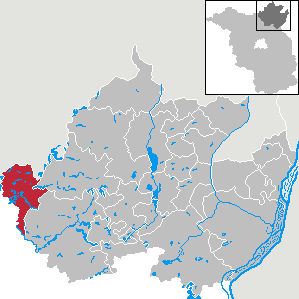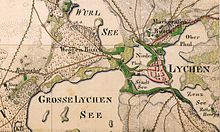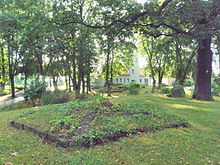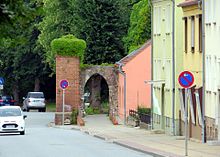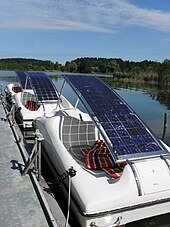Lychen
| coat of arms | Germany map | |
|---|---|---|

|
Coordinates: 53 ° 12 ' N , 13 ° 19' E |
|
| Basic data | ||
| State : | Brandenburg | |
| County : | Uckermark | |
| Height : | 60 m above sea level NHN | |
| Area : | 111.98 km 2 | |
| Residents: | 3178 (Dec. 31, 2019) | |
| Population density : | 28 inhabitants per km 2 | |
| Postal code : | 17279 | |
| Primaries : | 039888, 033087 (Schleusenhof Regow) | |
| License plate : | UM, ANG, PZ, SDT, TP | |
| Community key : | 12 0 73 384 | |
| LOCODE : | DE LYC | |
| City structure: | 4 districts | |
City administration address : |
Am Markt 1 17279 Lychen |
|
| Website : | ||
| Mayoress : | Karola Gundlach | |
| Location of the city of Lychen in the Uckermark district | ||
The Uckermark city Lychen [ lyːçən ] is a middle of the natural park Uckermark Lakes situated nationally recognized resort in the district Uckermark in the north of Brandenburg . Lychen carries the additional designation Flößerstadt . Due to its location in the Neustrelitz Kleinseenland , it is a popular holiday destination.
geography
In terms of nature , Lychen is part of the Neustrelitz Kleinseenland . The city lies between seven lakes in the Uckermark : Wurlsee , Großer Lychensee , Nesselpfuhl , Stadtsee , Oberpfuhl , Zenssee , Platkowsee . The urban area also includes other lakes such as the Großer Küstriner See or the Mellensee . In the south, Lychen has a share in the Himmelpforter Heide forest area with the former Tangersdorf military training area ; the area is part of the Kleine Schorfheide nature reserve . Lychen is connected to the Upper Havel waterway via the Woblitz and to the Feldberg lake landscape via the Küstriner Bach . In the north, the Lychens area borders on the Mecklenburg Lake District , in the west on the Oberhavel district .
City structure
According to its main statute, the city of Lychen (in addition to the core city) is divided into three districts and municipal parts:
- District of Rutenberg with the inhabited district of Eichhof
- Retzow district with the inhabited districts of Kastaven , Sähle and Wurlgrund
- Beenz district with the inhabited districts Marienheim and Stabeshorst .
The municipal parts of Küstrinchen , Seeberg , Tangersdorf and Türkshof belong to the core town of Lychen .
There are also the living spaces: At the Großer Lychensee, Lüder extension, Beenzer extension, Beenzhof, Birkental, Bohmshof, Brennickenwerder, Collinshof, Drei Seen, Dünshof, Purgatory, Georgenhöhe, Heckenhaus, Hinterfeld, Kolbatzer Mühle, Kuckuckswerder, Langes Werder, Lexoshof, Lindenhof , Marienhof, Mückenfang, Punskuhl, Reiherhals, Sängerslust, Schleusenhof Regow , Schlüßhof, Schreibermühle, Seeblick, Süßer Grund, Tonkünstlerheim, Vorderfeld, Wuppgarten and Zenshaus.
history
Beginnings
It was first mentioned in documents in 1248 as in Liechen . The spelling Lychen is considered proven for 1299. The first finds of a settlement in the Lychen area date from the Middle Stone Age . Slavs settled in the course of the Great Migration (5th – 6th centuries) . They built their settlements on islands and peninsulas and built refuge castles, such as B. the castle wall (current hotel "Lindenhof") on a peninsula in Wurlsee .
Margrave Johann I founded the city in 1248. It was given a six-meter high city wall and three gate towers, of which the Fürstenberger Tor and the Stargarder Tor are only partially preserved. In 1976, the Stargard gate tower collapsed in a strong storm. As a result of armed conflicts, Lychen fell to Mecklenburg in 1302 . 150 years later the Margrave Johann von Brandenburg recaptured the city and after the Peace of Wittstock it came back to Brandenburg. The Thirty Years War (1618–1648) and two large fires (1648 and 1732) destroyed almost the entire city several times. During the Seven Years' War (1756–1763) Lychen came under Swedish occupation.
Parts of today's urban area were owned by the Himmelpfort monastery in the Middle Ages . Linow was part of the original equipment of the monastery in 1299 and fell into desolation after 1342 . In 1307 Rudow and Tangersdorf came into the possession of the monastery and after 1342 also fell in desolation. Rutenberg was partially owned by the monastery from 1309 and completely from 1317.
19th century until today
The opening of the Britz – Fürstenberg railway in 1899 brought Lychen's economic development with it. A post office, pharmacy, train station and chapel were built by 1910. In 1901 Lychen received the first telephone connection to Templin and in 1903 his own newspaper - the Lychener Zeitung . Especially through the establishment of the sanatorium, jobs and apprenticeships were created in the construction, printing, laundry, household school, on the poultry yard, in the gardening and in the spa hotel, and Lychen developed into a climatic health resort. In the early 1930s Lychen recorded the highest number of overnight stays by summer guests in the province of Brandenburg. The sanatoriums looked after around 1000 patients and employed 380 Lychen residents.
In 1923 the villages of Hardenbeck , Rosenow and Warthe were separated from the Lychen district court. In February 1934 the NS-HAGO issued signs with the inscription German business . During the Germany flight from June 13-14, 1938, over 100 aircraft landed and took off in Rutenberg.
During the " Reichskristallnacht " ( Reichskristallnacht ), the cemetery of the local Jewish community in Stargarder Strasse behind the city gate, which has been based in the town since the 15th century, was desecrated and destroyed. In the Heinze und Blankert company from Berlin, which manufactured parts for grenade detonators and machine-gun ammunition from 1939, 20 to 25 prisoners from the Ravensbrück concentration camp worked every day . In 1942 the municipality bought the area of the Jewish cemetery and designed it as a small green area. A memorial stone erected by the Mecklenburg State Jewish Community has been commemorating the devastation of the cemetery since 1970 . In addition, the city administration had a plaque attached to the lower entrance, which keeps the events alive. The large oak on the hill is specially mentioned.
1957 Tangersdorf was incorporated into Lychen. From 1968 to 1990 the Himmelpfort special weapons depot was located southwest of Lychen . This former nuclear weapons depot of the armed forces of the Soviet Union is also known as Lychen II .
In the course of the formation of offices in the state of Brandenburg in 1992, the communities of Beenz, Retzow, Rutenberg and the city of Lychen merged on October 10, 1992 to form the Lychen office . The office was based in the city of Lychen. Lychen has been a state-approved resort since 1996 . On December 31, 2001, Beenz, Retzow and Rutenberg were incorporated into the city of Lychen and the Lychen office was dissolved. Since then, Beenz, Retzow and Rutenberg have been districts of the city of Lychen.
Since October 11, 2008, the city of Lychen has had the additional designation Flößerstadt , which was initially not part of the official name. The official confirmation by the Ministry of the Interior of Brandenburg only took place on May 23, 2013, which entitles the city to use the additional designation on the entrance signs.
Lychen and its current districts belonged to the Templin district from 1817 to 1952 (until 1947 in the Prussian province of Brandenburg , 1947–1952 in the state of Brandenburg ). From 1952 to 1993 they were part of the Templin district (until 1990 in the GDR district of Neubrandenburg ; 1990–1993 again in the state of Brandenburg). Since the district reform in Brandenburg in 1993, Lychen has been part of the Uckermark district .
Hohenlychen sanatorium
In 1903 Gotthold Pannwitz founded the Hohenlychen sanatorium as a community sanatorium belonging to the community sanatorium association of the Red Cross to fight tuberculosis , initially to treat sick children. After gradual expansion, Department XIV, the Kaiserin Auguste Viktoria Sanatorium, was built in 1912 and a hospital in 1913.
During the Second World War , the sanatorium, under the direction of Karl Gebhardt, was initially converted into an orthopedic clinic and then a hospital for the Waffen-SS . The lung specialist Kurt Heissmeyer worked here, among others , who from June 1944 carried out human experiments on Soviet prisoners of war in the Neuengamme concentration camp and infected twenty Jewish children between the ages of 5 and 12 from Auschwitz with tuberculosis in November 1944 .
Company holiday camp
During the GDR era, a number of companies in Lychen maintained holiday properties and company holiday camps for their employees and their children, for example the VEB Walzwerk Finow and the VEB motor vehicle plant " Ernst Grube " ( Werdau ) and the VEB Lacke und Farben Berlin in the Tangersdorf district at Zenssee .
Population development
|
|
|
|
|
Territory of the respective year, number of inhabitants: as of December 31 (from 1991), from 2011 based on the 2011 census
politics
City Council
The city council consists of 16 city councilors and the full-time mayor. The local elections on May 26, 2019 resulted in the following distribution of seats:
| Party / group of voters | Seats |
|---|---|
| Lychen is good | 7th |
| Nice here - together for Lychen | 4th |
| CDU | 3 |
| SPD | 2 |
mayor
- 1998–2002: Dieter Sommerfeld (SPD)
- 2002–2016: Sven Klemckow ( PDS )
- since 2016: Karola Gundlach
In the mayoral election on February 28, 2010, Sven Klemckow was elected for a term of eight years with 74.5% of the valid votes. The city council retired on January 31, 2016 for health reasons.
In the mayor's election on June 26, 2016, Karola Gundlach was elected as the new mayor for a term of eight years with 58.0 percent of the valid votes.
coat of arms
The coat of arms was approved on June 2, 1993.
Blazon : “In red over a blue-silver corrugated shield base, a silver castle, with two pyramid-shaped tinned towers, each covered with a black window, and a goalless tinned and square wall in between; above it, between two six-pointed silver stars, a silver shield with a gold-armored red eagle. “
The castle is supposed to symbolize the city wall with its towers. The waves represent the lakes around Lychen. Since Lychen belonged to the Mark Brandenburg, the eagle was included in the coat of arms. The stars in the coat of arms remind us that coins were minted in Lychen in the 14th century, on which the Margrave of Brandenburg was depicted between stars.
Town twinning
Lychen's twin cities are Hopsten in North Rhine-Westphalia and Czaplinek in the Polish West Pomeranian Voivodeship.
Attractions
The list of monuments in Lychen includes the monuments entered in the list of monuments of the state of Brandenburg.
- The Protestant town church St. Johannes was built in the second half of the 13th century as an early Gothic stone building.
- The town hall on the market square was built in 1748 instead of a previous building in the Baroque style and rebuilt after being destroyed in the Second World War.
- Large parts of the medieval city wall, built from field stones from 1302–1304, have been preserved. This also includes the remains of the Stargarder Tor , the Templiner Tor and the Fürstenberger Tor .
- The Schreibermühle housed a home for former prisoners of war founded by Elsa Brändström in the 1920s .
- In the rafting museum, which is housed in the former building of the volunteer fire brigade, one of Lychen's earlier economic foundations is honored.
- In the Retzow district, the ruins of a Gothic stone church from the 13th century are worth mentioning.
In addition, there is a Catholic Church, a New Apostolic Church , an open-air theater, the Malerwinkel and the Chors Stift in the city .
- Visitor center of the nature park with an exhibition on the geological formation and settlement history of the northwestern Uckermark as well as detailed information on accommodation and excursion destinations
- Heimatstube in the building of a former drawing pin factory with insights into the city's history (opened in 2012)
- The drawing pin was invented in Lychen in 1903 . Today a memorial commemorates the inventor Johann Kirsten .
tourism
Lychen can be reached by boat from Berlin or Hamburg via the Havel , through the Woblitz and the Großer Lychensee . Large parts of the Lychen area are part of the Uckermärkische Seenlandschaft nature park. Therefore, some lakes, such as the Wurlsee, are not allowed to be sailed with motor boats, the Küstrinchener Bach is not allowed to be used when the water level is low, otherwise only up to the first lock (in case of purgatory). Lychen's waters offer various opportunities for water sports, such as swimming, pedal boat , steamboat, raft or solar boat trips . The approximately 4 × 2 m large solar catamarans SOL 10 , which are stationed in Nesselgrund, have a motor output of 550 W (0.75 PS) at a speed of 5 km / h (around 2.7 knots) and can be used without a sports boat license . The solar cells also serve as a hood.
Also, trolley rides , wagon rides, nature walks or bike rides are possible. The Uckermärkische Radrundweg leads through Lychen (with connection to the long-distance cycle route Berlin-Copenhagen ). Every spring Lychen hosts the Lychener Seenlauf over a distance of 30 kilometers.
Lychen barrier-free
There are two paved, partially barrier-free circular paths of different lengths with information boards in the form of oversized thumbtacks, which point out interesting things as well as handicapped accessible toilets and the gradient of the paths. The passenger ship Möwe and the tourist raft Pläätz are accessible for guests in wheelchairs. There are wheelchair-accessible draisines on the Fürstenberg – Lychen route, and one of the Kremser in Lychen is equipped with a ramp. Two barrier-free holiday apartments can be found in the Sonnenhof apartment complex near the steamboat landing on the Stadtsee.
Economy and Infrastructure
economy
In earlier centuries rafting was one of the city's most important industries. Not only was timber assembled into rafts and brought to larger construction projects, often in weeks of work, but people also transported other non-perishable goods on the rafts.
With the establishment of the health resorts in the 20th century, tourism developed into an important economic base for the city. Furthermore, the construction industry with various trades of construction planning and construction, fishing with fish smoking and fish trade (in the Beenz district and on the Großer Lychensee), various therapeutic practices, car trade, car and truck service, timber trade, green space service, computer service, boat service and - sales and other companies based in Lychen.
traffic
In Lychen the cross country roads L 15 ( Fuerstenberg / Havel - Boitzenburg ) and L 23 ( Feldberg - Templin ).
The Fürstenberg – Templin railway, with stations in Lychen , Hohenlychen and Tangersdorf , has been used by tourists since 1996 as a route for bicycle draisines after it was closed . The connection to Fuerstenberg / Havel , Templin and other surrounding places today with the buses of the LAA ensured.
The Regow lock is located at kilometer 42.6 on the Upper Havel waterway at the Regow lock yard.
societies
- Lychen United (recreational sports)
- SV Germania Lychen (soccer)
- SV Berolina Lychen (handball, athletics)
- Sailing Association Lychen 1990 e. V.
- Lychener SV (billiards)
- Equestrian club (riding)
- Lychener Seen Lauf Verein
- Rifle Guild 1822
- Lychen rafting association
- Volunteer firefighter
- Tourist association
- Help for Eastern Europe
- Employment development association
- Hohenlychen sanatorium
- Grist to the mill
- Friends of Lychen Museum eV
Personalities
Honorary citizen
- 1838 Albert August Christoph Reinhard, pastor
- 1910 Julius Lilienfeld, head of the city council, hotel owner
- 1914 Sigmund Cohrs (1845–1924), patron of the children's sanatorium
- 2011 Gotthold Pannwitz (1861–1926): Doctor and founder of the Lychen lung sanatorium
sons and daughters of the town
- David Franck (1682–1756), historian, school principal and preacher
- Erika Pannwitz (1904–1975), mathematician
- Bern Carrière (1921–2015), psychiatrist
- Heinz Kluth (1921–1977), sociologist
- Rolf Ebert (1926–2013), physicist, university professor
- Freia Hoffmann (* 1945), musicologist
- Hans-Christoph Blumenberg (* 1947), film critic, screenwriter and film director
- Uwe Jähnichen (* 1962), painter, sculptor, gallery owner
Personalities with connections to the city
- Siegmund Cohrs (1845-1924), councilor of commerce, supporter of the Victoria-Louise children's sanatorium and sponsor of the Cohrs Foundation, donated 5,000 marks to the city of Lychen to set up a children's aid facility. In 1914 he was given honorary citizenship by the city of Lychen, which was revoked posthumously in 1939 .
- Johann Kirsten (around 1900), is considered the inventor of the thumbtack , lived in Lychen
- Karl Rätsch (* 1935), sculptor, has lived in Lychen since 1974
- Klaus Voormann (* 1938), musician and graphic artist, (close) friend of the Beatles , lived temporarily in Lychen as a child. In an interview he emphasized that he had no relationship with his hometown Berlin, as his childhood memories were in Lychen.
- Henryk Wichmann (* 1977), politician (CDU), member of the Brandenburg state parliament from 2009 until the end of January 2019 , lives in Lychen
literature
- Lieselott Enders : Historical local dictionary of the Mark Brandenburg, part VIII, Uckermark . Weimar 1986, ISBN 3-7400-0042-2 .
Web links
Individual evidence
- ↑ Population in the State of Brandenburg according to municipalities, offices and municipalities not subject to official registration on December 31, 2019 (XLSX file; 223 KB) (updated official population figures) ( help on this ).
- ↑ a b Lychen is now a raft town . In: Märkische Allgemeine , October 13, 2008, p. 5
- ↑ Main statute of the city of Lychen from July 6, 2009 PDF ( Memento of the original from December 3, 2013 in the Internet Archive ) Info: The archive link was inserted automatically and has not yet been checked. Please check the original and archive link according to the instructions and then remove this notice.
- ^ A b City of Lychen service portal of the state administration Brandenburg
- ↑ Development potential study Heilstätten ( memento of the original from August 26, 2014 in the Internet Archive ) Info: The archive link was inserted automatically and has not yet been checked. Please check the original and archive link according to the instructions and then remove this notice. of the LEG des Landes Brandenburg (2000), accessed on August 22, 2014
- ↑ 1923 ( Memento of the original from August 26, 2014 in the Internet Archive ) Info: The archive link was inserted automatically and has not yet been checked. Please check the original and archive link according to the instructions and then remove this notice. , accessed August 22, 2014
- ^ Information from the memorial plaque, as of August 2013
- ↑ Contribution to the statistics of the State Office for Data Processing and Statistics. Historical municipality register of the State of Brandenburg 1875 to 2005 7.15 pm District Uckermark PDF
- ^ Formation of the Lychen office . Announcement of the Minister of the Interior of October 6, 1992. In: Official Journal for Brandenburg - Common Ministerial Gazette for the State of Brandenburg , Volume 3, Number 82, October 26, 1992, p. 1918.
- ^ Incorporation of the communities of Beenz, Retzow and Rutenberg into the city of Lychen . Announcement of the Ministry of the Interior of December 10, 2001. In: Official Journal for Brandenburg - Joint Ministerial Gazette for the State of Brandenburg , Volume 12, 2001, Number 52, Potsdam, December 27, 2001, p. 902, PDF
- ^ Message from the Brandenburg Ministry of the Interior
- ↑ Hans Waltrich: On the history of the sanatoriums of the Red Cross in Hohenlychen
- ↑ Historical municipality register of the state of Brandenburg 1875 to 2005. District Uckermark . Pp. 18-21
- ↑ Population in the state of Brandenburg from 1991 to 2017 according to independent cities, districts and municipalities , Table 7
- ^ Office for Statistics Berlin-Brandenburg (Ed.): Statistical report AI 7, A II 3, A III 3. Population development and population status in the state of Brandenburg (respective editions of the month of December)
- ^ Result of the local election on May 26, 2019
- ↑ Results of the local elections in 1998 (mayoral elections) for the district of Uckermark ( Memento of the original from April 15, 2018 in the Internet Archive ) Info: The archive link was inserted automatically and has not yet been checked. Please check the original and archive link according to the instructions and then remove this notice.
- ↑ Mayor of Lychen. In: Neue Lychener Zeitung , May 28, 2014, p. 12
- ↑ Lychen's mayor is to retire . In: Nordkurier , September 22, 2015
- ↑ Section 74 of the Brandenburg Local Election Act
- ^ Result of the mayoral election on June 26, 2016
- ↑ Coat of arms information on the service portal of the state administration of Brandenburg
- ^ City of Lychen - twin cities , accessed on October 15, 2017
- ↑ Visitor Center ( Memento of the original from October 26, 2013 in the Internet Archive ) Info: The archive link was inserted automatically and has not yet been checked. Please check the original and archive link according to the instructions and then remove this notice. , accessed August 22, 2014
- ↑ A memorial to the inventor of the thumbtack. In: Potsdam Latest News , August 30, 2003
- ↑ solar boats on the website of the company. Button Solar Design, accessed on August 24, 2014
- ^ Uwe Werner and Tomas Morgenstern: rafts, drawing pins, club flags. The city of Lychen is rich in symbols and traditions - the latter includes club life. In: Neues Deutschland, July 30, 2018, p. 12
- ↑ Lychener Chronik , accessed on August 22, 2014
- ^ Lychen city chronicle. Ten decades in the 20th century PDF
- ↑ Katrin Bischoff: On the wrong track . In: Berliner Zeitung , February 7, 2009
- ↑ uwe-jaehnichen at Kulturserver-brandenburg.de; Retrieved February 13, 2011
- ^ Karl Rätsch culture server of the state of Brandenburg; Retrieved February 13, 2011

